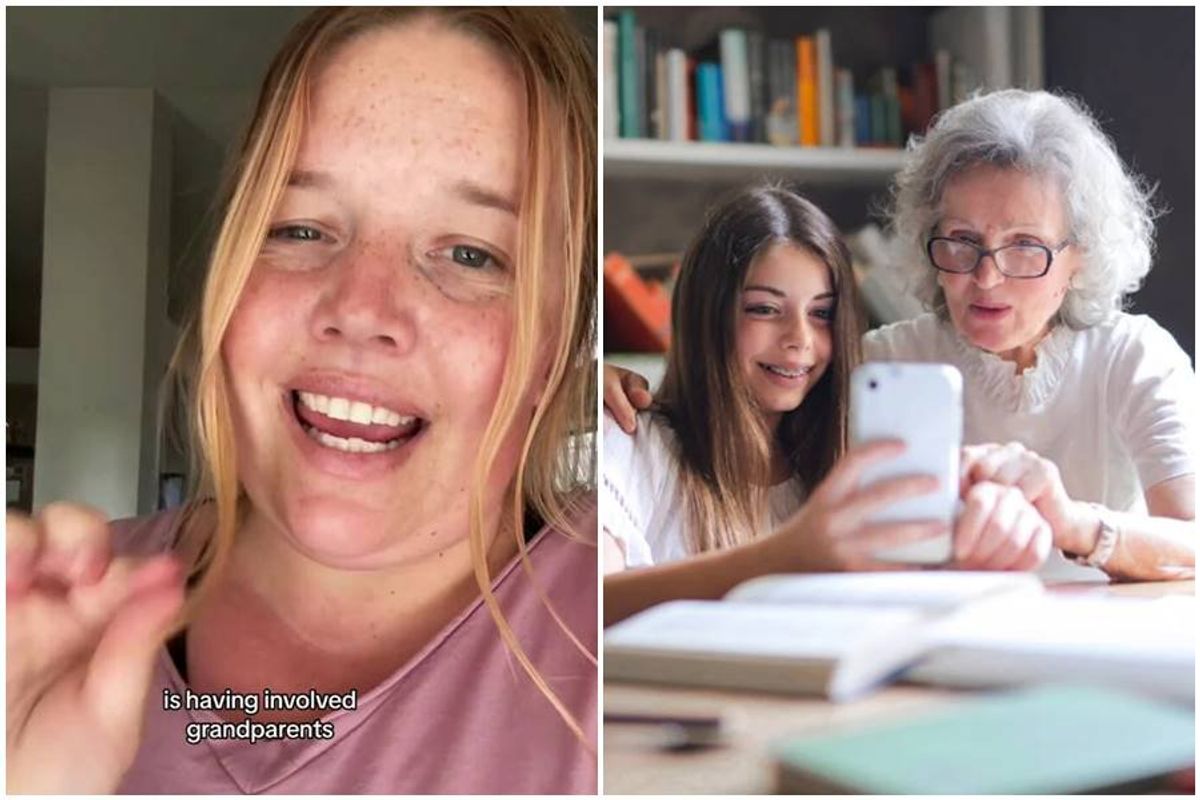Mom claims the biggest 'parenting flex' is having grandparents who are 'voluntarily involved'
Grandparents that are eager to help raise their grandkids are a game-changer.

Kelsey shares why it's great to have involved grandparents.
Grandparents are often stereotyped as doting and eager to be a big part of their grandchildren's lives. In movies and TV, we often see parents of child-free women begging them to have kids so they can be grandparents.
However, that’s not always the case. Many grandparents are unable to help raise their grandkids because of their location or health. There are also far too many who aren’t that eager to do the work.
For many parents, the presence of grandparents who actively participate in raising their kids can be a game-changer. The support they provide, whether it’s watching the kids on a Friday night or picking them up from school, can significantly ease the juggling act of modern parenting.
Kelsey, a popular TikTok and Instagram mother of two, recently celebrated the joy of having “voluntarily involved” grandparents, calling them the biggest “parenting flex.” Of course, the subtext of the post is that, unfortunately, many grandparents are uninvolved with their grandchildren’s lives and their families could use their help.
Warning: Strong language.
@kelsey_p90 Top tier 🙌🏻🙌🏻 #fyp #foryourpage #foryou #momtok #mom #moms #momlife #momsbelike #momsoftiktok #sahm #grandparents #grandparentsoftiktok #grandma #grandpa #parenting #parentsoftiktok
“Without question, the biggest parenting flex isn’t the mom car, not how much you make a year. It’s not how well-behaved your kids are,” Kelsey starts her video. “Biggest flex is having involved grandparents. Voluntarily involved. Holy f***, having that midday struggle with my children and then getting that text from grandma: ‘Hey, can I pick so and so up for a sleepover tonight?’ Ha ha ha, funny, you should say that! Her bag has been packed. Never unpacked it. She’s ready.”
She noted that “voluntarily involved” grandparents aren’t just doing the bare minimum. They’re stepping up and taking charge of their role in the family.
“Ones that you can text like, ‘Hey, can you fly up this weekend? We need your help.’ ‘Sure, no problem!’ I don’t know what kind of reaction that was. But it came within the depths. Nothing beats it. Nothing beats a grandparent that wants to do more than required to get that yearly Facebook Happy Birthday Grandma post,” Kelsey continued.
Unfortunately, many moms and dads don’t have parents they can rely on to help them raise their kids and it’s a big loss. “A lot of the times, people don’t have help, and I am sorry,” Kelsey said. That f****** blows. We know it’s their loss. We know. Who doesn’t want to be involved with their grandchildren?”

A grandmother looks out the window with her granddaughter.
Many commenters shared why raising kids without grandparents is so hard.
"I recently read a quote that said 'uninvolved grandparents never intended to be parents themselves' everything made sense," Isabel Cardenas wrote. "You definitely got that right. That is the biggest flex of all time. There’s not enough money in the world that would take the jealousy I have for people who receive that type of love freely," Katy Alltop added.
Kelsey shared her thoughts on why some grandparents aren’t voluntarily involved with their grandkids.
“I think a lot of times grandparents have the point of view like ‘I did my time, I raised my children, now it’s my time to do whatever I want.’ They don’t want to be tied down with babysitting and other commitments,” she told Upworthy. “Which I don’t think is necessarily a bad thing! They deserve a fun retirement. I would never want to force a grandparent (or anyone really) to be a part of my children’s lives. But it is so nice to see so many grandparents who go out of their way to foster relationships with their grandkids and who want to spend quality time with them (not just to give mom and dad a break).”
- People share unforgettable stories told by their grandparents, and some are just insane ›
- Why this grandmother's advice went viral and is so very needed right now ›
- Grandma asks if she was wrong to take her grandkids to Disneyland ... ›
- Fed up parents explain why they 'never want to bring the kids over' - Upworthy ›
- Grandkids surprise grandpa for 70th birthday by recreating funny old photos - Upworthy ›





 Rihanna Nails GIF
Rihanna Nails GIF

 Good luck trying to catch a gazelle.
Good luck trying to catch a gazelle. Chickens will eat just about anything.
Chickens will eat just about anything. There's actually a big difference between horses and zebras besides just the stripes.
There's actually a big difference between horses and zebras besides just the stripes. Stop Right There The End GIF by Freeform
Stop Right There The End GIF by Freeform